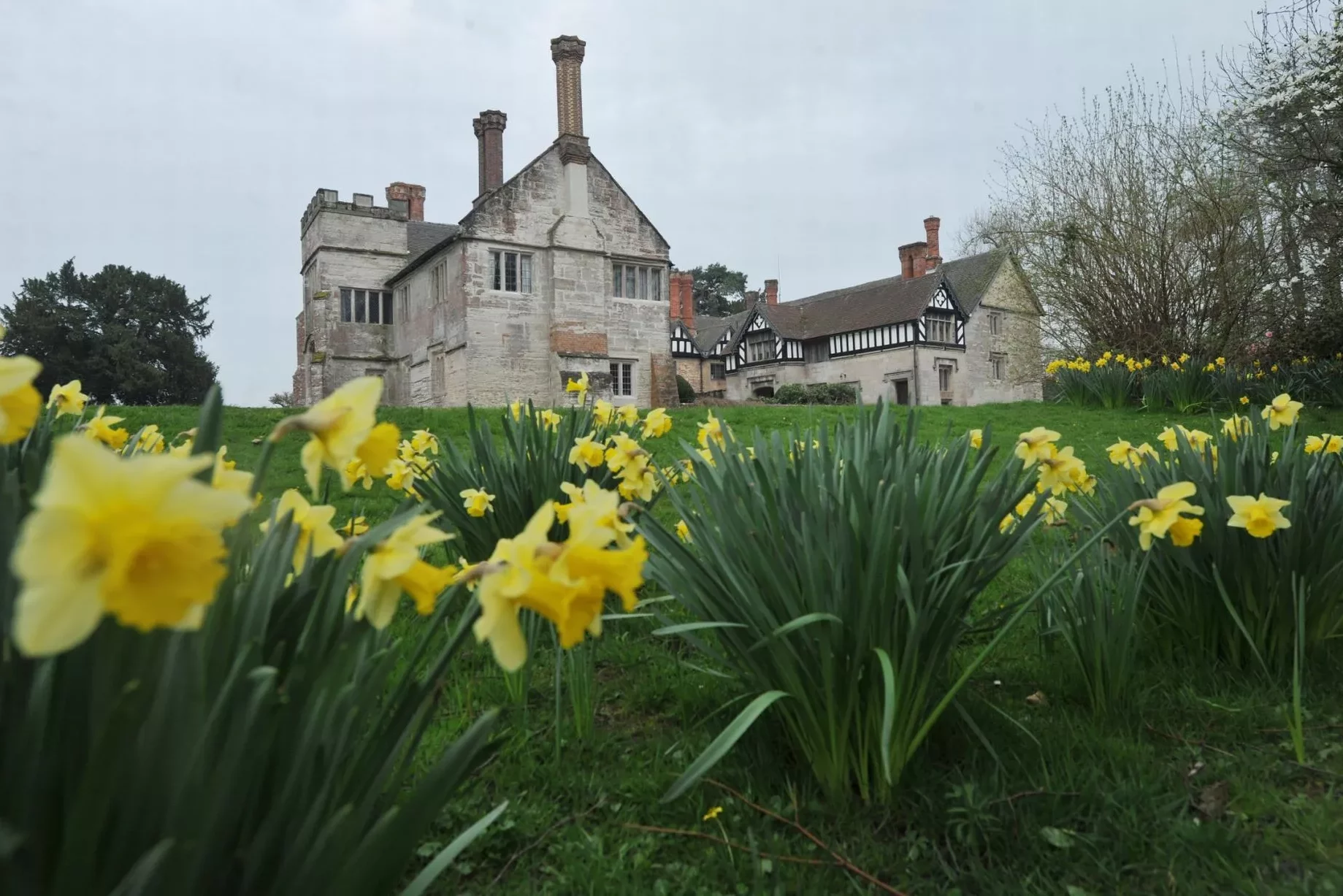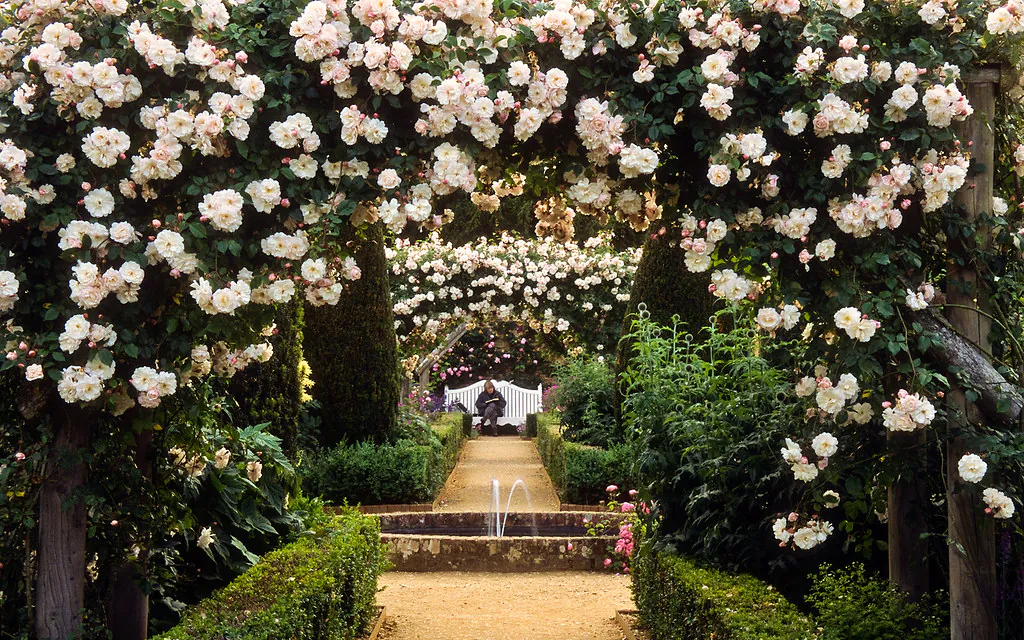Greys court, Oxfordshire (Greys court, Oxfordshire)

“Jewel”, “gimmick”, “old box” – what only epithets this amazing garden was not honored with. Enclosed by a brick wall, it is divided into several “orchards within an orchard” – pink, white, kitchen and even cherry (but not Chekhov’s!). The space here feels wonderfully rich, and every corner is filled with beautiful colors and holds little secrets worth discovering and unraveling. Fancifully shaped trees, bent into arch-crowns by the whim of gardeners. Ivy-covered walls with wrought iron lace of low wickets – you have to bend down to enter the mysterious space behind the door. Delicate purple vaults of wisteria, which bloomed later than usual this year. Finally, the picturesque Chiltern Hills around it are pastoral with sheep grazing among the emerald grass, transforming Grace Court into an enchanting vision of Renaissance Arcadia.

Late May and June is blooming time for roses and irises. It is for their sake that many people come to the estate, famous for its rose garden. The Queen of Flowers also played a special role in its history: Henry VIII gave Grace Court in 1514 to Sir Robert Knollys. In return, Nollis pledged to make a symbolic payment of one scarlet rose each year, on the summer solstice. His son Sir Francis became Privy Counselor to Elizabeth I and was rumored to be the prototype of Shakespeare’s Malvolio. And three generations of feisty red-haired women – the two Letitia’s and Catherine, Robert’s wife, daughter and granddaughter – made the estate famous not only for its beauty but also for its daring enterprise.

Grace Court seems to epitomize the “merry England” of the Tudor era. However, the garden in its present form was created in the 20th century by the new owners, the Brunner couple, who were friends of Octavia Hill, one of the founders of the National Trust. The turf labyrinth appeared here in 1980 – after a speech by the Archbishop of Canterbury about the confusing situation in which our world finds itself and from which we are all searching for a way out. The main house, on the other hand, is really Tudor in architecture. A little austere on the outside, it’s quite different on the inside – full of light and coziness, with airy 18th-century moldings. Don’t miss the opportunity to stop by the elegant town of Henley-on-Thames nearby, famous for its Royal Regatta – it takes place on the first Sunday in July.
Hidcote Manor, Gloucestershire (Hidcote Manor, Gloucestershire)

A Cotswold treasure, the garden at Hidcote is widely regarded as one of the most famous in England. Experts have repeatedly included it in the top most visited and the Royal Horticultural Society has presented it with awards. Quirky in layout, it was invented in 1907 by American Lawrence Johnston, who became a British citizen over the years and even served in the British Army and was severely wounded during World War I. However, with its somewhat excessive regularity, carefully trimmed topiaries (figures made of trees and bushes) and the pattern of “garden rooms” passing into each other, it is somewhat reminiscent of the French gardens of the Côte d’Azur. Johnston actually moved to Mentona in the twenties, creating another garden there, Serre de la Madone. However, he kept returning to Hidcote, enjoying his first child and the mild English summer.

The garden at Hidcote was laid out under the influence of the British Arts and Crafts movement. And yet one expects a view of the Mediterranean Sea beyond its two axes, on which most of the “garden halls” are strung. The green rooms all have quirky names – there’s a “theater lawn” and a “garden of columns,” for example. The feeling of “Frenchness” is enhanced by paired vases in the antique spirit and tea gazebo gazebos, laid with ceramic tiles with a subtle pattern of floral garlands and sailboats. And yet this is the most quintessentially British garden, with its delicate color palette and variety of plants from the collection of Johnston, who brought 65 new botanical species to England (25 are now named after him or Hidcote). And the carefully trimmed trees suddenly lead out to a meadow of daisies, sheep and Cotswold hillside scenery.
The main house at Hidcote is pleasant to look at, but not striking in terms of architecture or interiors. But close to the estate, literally three minutes away, is Kiftsgate Court Gardens, famous for its collection of old garden roses and cascading gardens. As well as the many villages of the Cotswolds, beckoning tourists all year round.
Packwood House and Baddesley-Clinton.
The families who once lived on these two estates in the Shakespearean county of Warwickshire were friends, constantly visiting each other and buying furniture from their neighbors. So it makes sense to walk through two very different, but very close by gardens on the same day.
Packwood House, Warwickshire (Packwood House, Warwickshire)

Despite its name, Packwood House is famous not for the house – interesting but rather modest – but for its unique topiary yew park. It was laid out in the 17th century, but the bulk of it was already planted in the 19th and 20th centuries. According to a legend passed on by word of mouth by the gardeners, the trimmed trees of different geometric shapes symbolize the Sermon on the Mount: thus, the 12 largest yews are the “apostles” and another 4 in the center are the “evangelists”. The smooth rows of columnar trees seem gloomy and as if descended from the paintings of René Magritte.

However, British architect and landscape designer Geoffrey Jellicoe considered Packwood the quintessentially English garden – for its lack of finality and unified plan, as well as its slight veneer of mysticism. And here you can admire not only the indispensable rose garden, but also an imitation of a “wild” landscape – cultivated plants, meadow grasses and even wormwood, thistle and muzzlewort, which we used to consider weeds, bloom in the flowerbeds next to each other.
Baddesley Clinton Hall, Warwickshire (Baddesley Clinton Hall, Warwickshire)

The garden at Baddesley Clinton is not at all like Packwood. It’s more like a wild forest (you can walk through it to the neighboring estate, by the way) than a regular park or a modern design experiment. At its center is a fairy-tale mini castle surrounded by a deep moat dug in the 13th century that is still filled with water. Built at the end of the 16th century, the house has been owned for 500 years by the same Ferrer family, tracing its lineage back to William the Conqueror. It is full of beautiful furniture, stunning stained glass windows and embroideries. Judging from the interiors, the Ferrers were pleasant people with good taste, but somehow kept getting into colorful stories. The main local curiosity is a secret underground passage where Catholics were hidden from Protestant “priest hunters” during the 17th century Civil War. A piquant detail: it was located under the latrine, so none of the pursuers thought to look there. There are also “towers of redemption”, built in the 15th century by the duellist and bretherette owner who killed the priest who kissed his wife, and drawing rooms with paintings by the owner of the castle, Rebecca, who lived here in the 19th century as a “quartet” with her husband and another couple. However, these somewhat frivolous stories are best learned on the spot from the friendly caretakers: they won’t mind telling you all the latest gossip of bygone times.
Mottisfont Abbey, Hampshire (Mottisfont Abbey, Hampshire)

The main reason to visit Mottisfont in late May-June is its world-famous rose garden, which has been given the status of “national collection”. In 1972, one of Britain’s most famous breeders, Graham Stuart Thomas, planted more than 400 species of old-fashioned garden roses here. Small and large, stalked and plaited, trellis and boll, damask and tea, terry, table-petal and even “mossy” – just listing their species is breathtaking. Arches of rose bushes bow their heads to visitors who lose their heads at the lovely, fragrant blossoms. However, it’s not just about their beauty or their romantic names – preserving old species from extinction helps the cause of biodiversity and allows us to see them exactly as our ancestors enjoyed them.

The brick-walled square garden is divided into four parts. The roses here are mixed with other flowers and trees. Their subtle fragrance is intertwined with the tart smell of lavender. Peonies and delphiniums add colorful touches, while yews and apple trees frame an already perfect picture. Of course, much of Mottisfont is dedicated to the queen of flowers, and you can even try pink ice cream at the café here. But there are many other interesting things about the Abbey. For example, almost 300-year-old sycamore tree, one of the oldest in England, deserves special attention. The large Tudor mansion stands on the very spot where, in the early 13th century, industrious Augustinian monks founded a small monastery with vegetable gardens and an orchard. The art collection assembled by the widow of the last owner of the estate is also of interest. The elegant Maud Russell is known not only for her romances with bohemians (such as Jan Flemming), but also for her war diaries.
The rose season is said to begin in Mottisfont on May 25-27, with the most flowers unfolding in the second week of June. Unlike modern hybrids, many old-fashioned roses bloom only once a year, so you can visit the garden several times a season and always see something new.
Chartwell House, Kent.

When Winston Churchill first came to Chartwell, he was immediately won over by the view from the hill. Love at first sight proved to be an overhead: the estate was in deplorable condition. The old house had a leaky roof, the rooms were dark and cold, electricity was non-existent, and the sewage system was the same as it had been 400 years earlier when Henry VIII, who was courting Anne Boleyn, stayed here. But the green valleys of Kent so captured Churchill’s heart that he decided to buy the house in secret from his more sober-minded wife. Clementine was right – they had to invest four times more in renovations than the modest estate was worth. A separate item of expense was the work of the landscaper: rails had to be laid for the digging of the lakes alone. However, the result was worth it and Chartwell became the home of the Churchill couple for many years. But the hole in the budget has not been patched. But thanks to the help of friends, Chartwell passed into the hands of the National Trust in 1946, and Winston and Clementine remained to live there for a small rent.

However, Mrs. Churchill was charmed by Chartwell no less than her husband and even tended the garden herself. She created a beautiful rose garden: now the gardeners continue to plant her favorite varieties of roses in it. And also chose for the “street of butterflies” the most melliferous flowers – purple lavender, verbena and buddleia, pink and white echinacea, bright yellow helenium. The family realized their dream of a garden paradise together. Winston, who wanted to bring back to Britain a love of his native land, bred butterflies himself. Putting on his apron, he would turn into a mason, spending hours laying out the garden walls. Here you can also see the studio house where the politician painted the pictures that now adorn its walls. Son Randolph planted the Golden Rose Alley, giving it to his parents for their golden wedding anniversary. And daughter Mary got up early every day so she could feed the goats in the blossoming apple trees before school – a real idyll, if the animals didn’t chew on the bark.
And if you’re particularly lucky, you’ll meet a ginger cat called Jock in the garden or in the huge park (you should leave time for a walk!). Of course, this is not the pet that attended dinner parties and prime minister’s cabinet meetings. But the present young “Jock Number Seven,” as he is called on the estate, looks exactly the same as he did when Winston and Clementine were alive. After all, according to the will, “a red cat, with a white mani on his chest and four white socks on his feet” must always live in Chartwell.
